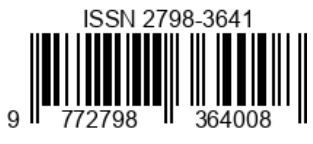CRUDE PROTEIN CONTENT, CRUDE FAT AND CRUDE FIBER FERMENTED CASSAVA TUBER PEEL (KUUK) WITH ECO ENZYMES
Keywords:
Eco Enzyme, Fermentation, Nutritional Quality, Cassava Tuber PeelAbstract
This study aims to determine the nutrition of cassava tuber skin (KUUK) fermented with eco enzyme. The method used in this study was using a Factorial Complete Randomized Design (RAL), which consisted of 3 treatments, namely P0 = Cassava tuber skin without fermentation; P1= Fermentation of eco enzyme 10 ml; P2 = Fermentation of eco enzyme 20 ml, and repeated as many as 5 repeats. The observed modifiers were changes in crude protein content, crude fiber, and crude fat. The results showed that fermentation of cassava tuber peel (KUUK) had a very noticeable effect (P< 0.05) on crude protein, crude fiber and crude fat. The conclusion of this study is that the best nutritional content is obtained in E2 treatment (fermented eco enzyme 20 ml) with crude fiber nutrient content of 6.960%, crude protein 7.538%, and crude fat 0.321%.
References
Alkadri, S. P.A., dan KristinD.A, 2020., Pelatihan Pembuatan Eco-Enzyme Sebagai Hand sanitizer dan Desinfektan Pada Masyarakat Dusun Margo Sari Desa Rasau Jaya Tiga Dalam Upaya Mewujudkan Desa Mandiri Tangguh Covid-19 Berbasis Eco-Community. Jurnal Al-Ribaath Vol 17, No 2 (2020)
Arun, C. & Sivashanmugam, P. 2015. Investigation of biocatalytic potential of garbage enzyme
Ayuningtyas, I., Hartini, S., & Cahyanti, M. N. 2016. Optimasi Pembuatan Tepung Ferkusi (Fermentasi Kulit Singkong) Ditinjau dari Variasi Penambahan Angkak. Jurnal aplikasi teknologi Pangan, 5(2).
Devita, M., Rizqiati, H., dan Pramono, Y. B. 2019. Pengaruh lama fermentasi terhadap kadar alkohol, lemak, nilai ph, dan total BAL kefir prima susu kambing. Jurnal Teknologi Pangan 3(2):204-208.
Helmiati, S., Rustadi, R., Isnansetyo, A., dan Zuprizal. 2020. Kandungan nutrien dan antinutrien tepung daun kelor sebagai bahan baku pakan ikan. Jurnal Perikanan 22(2): 148-156
Galintin, O., Rasit, N., & Hamzah, S. (2021). Production and characterization Of Eco Enzyme Produced from Fruit and Vegetable Wastes and Its Influence on the Aquaculture Sludge. Biointerface Research in Applied Chemistry, 11(3), 10205–10214. https://doi.org/10.33263/BRIAC113.1020510214
https://foodreview.co.id/blog-56213-Peran-Bakteri-Asam-Laktat-dalam-Proses-Fermentasi.html
Muliarta, I. N., & Darmawan, I. K. (2021). Processing Household Organic Waste Into Eco-Enzyme as an Effort to Realize Zero Waste. Agriwar Journal, 1(1), 6–11. https://ejournal.warmadewa.ac.id/index.php/agriwar/article/view/3658
Panjaitan, I., 2022. Pemberian Ekoenzim Dalam Air Minum Terhadap Persentase Karkas, Irisan Karkas Komersial Dan Bobot Organ Dalam Ayam Lohmann. Skripsi Universitas Sriwijaya.















